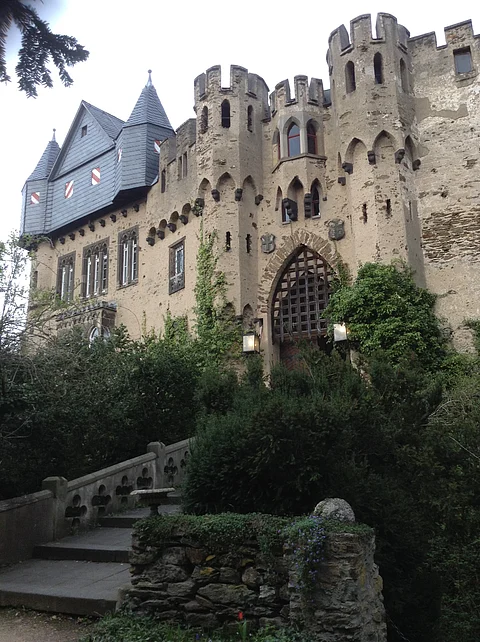

Lahneck Castle is a fortress steeped in history and horror by the picturesque Rhine River, some 600 kilometers from Germany's capital Berlin.
Our brush with this stronghold was part of our AmaWaterways River Cruise, where we sailed on a leisurely multi-day exploration of all sights and sounds, regional culinary feasts, vineyards after vineyards of excellent wines of the rivers Rhine and Moselle, all while disembarking at ports-of-call of tiny yet pretty villages, to relish the entire day — and in this case, even the evenings.
On this specific European trip — the more-than-just-a-riverboat — had a curated itinerary we could customize — we chose between various high-intensity or laid-back activities on a daily basis. While the young ones opted for adrenaline-pumping goings-on, we immediately snapped up the opportunity to have an after-dusk tour of the much-talked-about fort.
After our rather earlier-than-usual dinner at the Captain's Table — by invitation only — we set off for an eerie tour that will be difficult to forget.
An inspiration even to German playwright, critic, poet, scientist and statesman Johann Wolfgang von Goethe, Lahneck Castle was the spark for his poem "Geistesgruß" or "Ghost Greetings." If that wasn't enough reason to visit, we don't know what else would have convinced us!
Upon entry to just-unlocked rusty iron gates, we immediately noticed the age-old rather unkempt vines — with more dried leaves than fresh ones — that crept up all over the walls, giving the entire area a creepy feel. And to add to this, the moment we gingerly stepped inside, a plethora of flickering candles — all already with drips — on even floors, on top of broken tables, suspended from beams of ceilings, served as illumination from the darkness. We asked ourselves "Where is the draft coming from?"
The first shocking tidbit offered to us by a hoarse-voiced lived-in tour guide was that the legendary Knights Templar took refuge in this bastion. When Pope Clement V ordered to disband the Order, the last 12 soldiers swore to never abandon the sanctuary as long as they were alive. Here, they were slaughtered in bloody combat against the party of Mainz Archbishop Peter of Aspelt, who brought the archbishopric to its highest peak.
We were then earlier forewarned of a spooky yet tragic story, which we finally heard in full from our invested tour guide. In 1851, a Scottish family went on holiday at Lahneck, when suddenly their 17-year-old daughter Idilia Dubb disappeared.
After hours of fruitless search, she was not found. Years later, it was revealed that as the daughter climbed the deserted high tower, the wooden stairs mysteriously collapsed behind her. She was stuck. Her cries went unheard, due to the thick citadel walls
She chronicled her exile in her diary, which was likewise discovered in the walls. The last words she penned down were "All I know is that there is no hope for me. My death is certain… Father in heaven, have mercy on my soul." There were two hearts drawn beneath this line. Today, rumors say she still appears in the halls from time to time, begging for help.
Here are other bizarre spots you should see on your Lahneck Castle visit:

Unsettling Diorama: 1920s Dollhouse
A miniature dollhouse lit up by tiny lightbulbs is a curious sight, with doll-like figurines busy with mundane tasks. It was purportedly owned by a loving granddaughter of the English engineer who supervised the renovation in the 1800s.

Eternal Watcher: Queen Victoria painting
During the citadel's ownership under a certain Earl Kleist-Tychow, a massive life-sized painting of a young Queen Victoria — who ruled the United Kingdom of Great Britain and Ireland from 1837 to 1901 — was brought into the abode. With no identifying marks or signatures, historians and experts till debate on who created this obra. Today, it is tucked away in a room, where it commands an entire wall due to its sheer size.

Holy Reprieve: The Chapel
With five windows, a few delicate stained-glass panels and a Gothic wrought iron chandelier, the stark chapel was faintly aglow with more candles which are dedicated to Saint Ulrich of Augsburg, who was the very first saint to be canonized not by local authorities, but by the Pope himself — in this case, Pope John XV on July 4, 1993.

Fallen Remembered: World War I Memorial
In the hearth, where some paintings and a fireplace find their solace, a gold and black plaque caught our eyes. Dated 1914-1918, it serves as a World War I marker, which lists out the victims of the war who perished.

Harrowing Discovery: Bergfried
Accessible from the outside, but due to the passing of time, compounded with several skirmishes survived, the wooden interiors of the Bergfried or Keep have been torn down and repaired several times over. This is the same tower where Idilia Dubb was mercilessly trapped. Her diary has since been published under the title The Missing Girl: The Records of Idilia Dubb. Bless her soul.
These are our five spooky postcards. What's yours?
